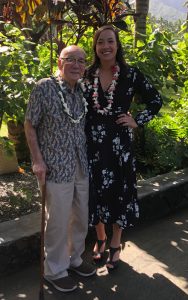Stories of tribes untouched by the modern world have enthralled humanity for hundreds of years. In 1972, Massey alumnus Doug Yen was packing his bags to investigate one such tribe in the middle of a rainforest of Mindanao in the Philippines. But how did a man from New Zealand, whose father had envisioned him as a medical doctor, end up in a rainforest in South East Asia?
Born in Wellington to Ernest Hai and Lily Yen, Yen says his father wanted what every Chinese father wanted – a doctor in the family. So he sat an exam in Wellington. But an opportunity to study agriculture at Massey or Lincoln presented itself. So he packed his bags for Palmerston North in 1944.
Things were a far sight different back then, as World War II had stripped what was then known as Massey Agricultural College of most of its staff, and students were away in the war. “I admit, I didn’t know the first thing about agriculture,”
Yen says. “I didn’t know one end of the cow from the other. So they made me go early and stay in the old hostel next to the refectory for some introductory work. Our freshman degree class numbered about six.”
But the classes were later augmented by returned servicemen completing their degrees and new students from the establishment of horticulture.
In 1947 Yen made college history as the first student of Asian descent to graduate, with a Bachelor in Agricultural Science. He followed this with a field husbandry thesis on root development in grasses and clover and a Master in Agricultural Science in 1948. “Students would be shocked at the equipment I was using then. You wouldn’t believe how primitive it was, but we made do with what we had.”
Out of university, he began work with the Department of Scientific and Industrial Research (DSIR), first as a plant breeder at Lincoln, then in 1953 in charge of the vegetable section of the division, where he bred varieties (garden peas and horticultural beans and tomatoes) with resistance to various diseases.
In 1957 he began research on the sweet potato, arguably his best-known work, receiving grants from the Rockefeller Foundation, which took him all over the world to collect samples. However, DSIR decided the collection was becoming too vast to manage. So Yen sent the collection to Japan where it was preserved in a special germ plasma bank, protecting what would otherwise have been lost. The New Zealand samples would eventually make their way back for preservation in New Zealand and for researchers to study here.
After this, Yen decided to head to the Bishop Museum in Honolulu, becoming an ethnobotanist, a person who studies a region’s plants and their practical uses through the traditional knowledge of a local culture and people. “The Bishop Museum appointment was significant, not just to my career but to Pacific prehistory in general.”
The most significant project was the Southeast Solomon’s Project with Professor Roger Green of the University of Auckland. Financed with two major grants from the United States National Science Foundation in 1972 and 1976, it significantly contributed to the archaeology and knowledge of agricultural systems of the Melanesian and Polynesian islands, as well as in developing the careers of younger archaeologists who participated.

Doug Yen with his granddaughter Lily Clayman.